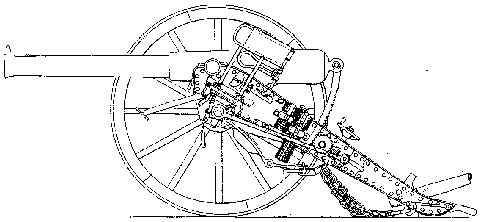The Gun - Rifled Ordnance: Field ArtilleryOrdnanceManufacture of RML field guns began in 1871 with a 9-pr 8-cwt (3-inch) followed by lighter (6-cwt) gun, both for horse artillery. At the same time a 16-pr 12-cwt (3.6-inch) gun was introduced for field batteries. Each was constructed of a steel barrel over which was shrunk a wrought iron jacket. Rifling on the Woolwich system consisted of three grooves with a uniform twist of one turn in 30 calibres.In 1879, following complaints that the 9-pr lacked power, a 13-pr 8-cwt (3-inch) gun was proposed for both horse and field. By this time improvements in equipment and ammunition , eg the de Bange obturator (1872), Vavasseur's copper driving band (1874), plus the fact that guns were becoming too long to be conveniently loaded from the muzzle, strongly supported a return to breech-loading. Consequently, two guns were prepared for trial, a breech-loader and a rifled muzzle loader. Compared to other field guns then in use, both BL and RML, local and foreign, both performed remarkably well in power as well as in accuracy. But it was the RML piece which went into production; the diehards had won again!. As the 13-pr closely resembled both the 9-prs and the 16-pr, a drawing of it is reproduced below. It differed from the latter guns mainly in its rifling, a polygroove plain section (PPS) of 10 grooves with a twist of one turn in 100 calibres increasing to one in 30 at a point nine inches from the muzzle where it became uniform. The 13-pr developed a muzzle velocity of 1390 feet per second and achieved a range of 6000 yards at 19° elevation. |
 Carriage, Field RML 13-pr No RML field equipments were ever used in New Zealand. |
| The 13-pr proved unpopular with Gunners who complained of excessive recoil so its issue was limited to a few batteries only. In those days a gun had no spade; when fired it recoiled several feet and had to be 'run out' to the firing position after each round, a tiring business in a prolonged action. Makeshift arrangements with brake and drag shoe to deal with the problem were ineffective. Although Armstrong's design of 1859 had included a recoil mechanism and Dr Siemens in 1867 had suggested a hydraulic buffer, progress in handling recoil in field artillery was to be painfully slow. For an explanation we must look at the problem of mobility. Guns were horse-drawn; the heavier the load behind the team the shorter the distance it could cover before the need to rest. Therefore designers of carriages were obliged to keep them as light as possible; indeed the obligation became an obsession. Positive steps to include recoil mechanisms were not taken until the adoption of more powerful BL field guns in 1881. CarriagesThese were usually called 'travelling carriages'. With RML ordnance came carriages of wrought iron and steel (later all-steel) of about the same weight as the wooden types they replaced. Wheels were still of wood but the wooden naves had given way to 'metal', ie bronze.Instead of the old pole-type trails which restricted elevation to about 15° the new trails consisted of two side brackets connected together at the trail eye and by one or more transoms. Trunnion bearings were fitted at the front, there being no separate saddle. This construction allowed rather more elevation despite the position of the elevating gear. One innovation with the new carriages was an elevating arc attached to the cascable and operated by a handwheel via a worm and pinion (as shown in the Figure above). This gear enabled the gun to be elevated or depressed more quickly and easily than with the old screw which had been in use since 1578! On the limbers iron was used for the general framework and wood for the footboards, boxes, etc. Wheels were interchangeable with gun wheels. Shaft draught continued to be used; pole draught was not officially introduced until 1895 although it was used in New Zealand and India with earlier equipments.
WL Ruffell previous | index | next | History index | Home |